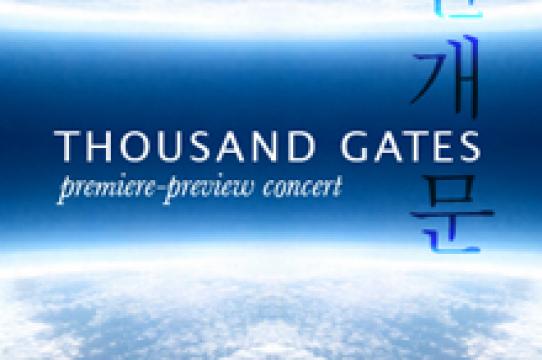The critically acclaimed Borromeo String Quartet, one of America’s leading string quartets, and star performers of traditional Korean instruments will perform a program featuring Andrew Imbrie’s Clarinet Quintet, Hi Kyung Kim’s Thousand Gates with images by Korea's renowned photographer Bohnchang Koo, and Kim's new work for string quartet, Han San.
The Borromeo Quartet is the ensemble-in-residence at the New England Conservatory. Ensemble Rituel features the Borromeo’s Nicholas Kitchen, violin, and Yeesun Kim, cello, along with John Sackett, clarinet, William Winant, percussion, and three of Korea's most prominent traditional performers: Soo-Neon Chung, haegeum (fiddle); Jeong-Seung Kim, daegeum/tungso/danso (flute); and Eun-Ha Park, Korean percussion. Camille Chitwood will conduct the Ensemble.
Download the Thousand Gates poster.
THOUSAND GATES Preview Presentation Schedule
April 4, 2013 Asian Art Museum, San Francisco (Samsung Hall)
April 5, 2013 University of California, Santa Cruz (Recital Hall)
April 7, 2013 Smithsonian, Washington, DC (Meyer Auditorium)
Part of UCSC's "April in Santa Cruz" festival of contemporary music.
Tickets will go on sale on Feb 27 at santacruztickets.com. In person or by phone at the UCSC Ticket Office (459-2159) and the Santa Cruz Civic (831-420-5260).
$12 general
$10 seniors (62+)
$8 students w/ ID
parking $4
doors open at 7:00 PM.
***
Additional Event:
Graduate Student Composition Reading Session
by Borromeo String Quartet from Boston
"Ballroom Dancing #1" by Ittai Rosenbaum and "Jettison and Divergence" by Joshua Spitzbergen
Monday, April 1 at 2:00 PM
Admission is Free
Music Center 131
Notes on the Pieces:
Ballroom Dancing was written during my visit to the Darmstadt International Music Courses in July 2012. It is based on a rumba pattern put under a magnifying glass, its particles dissected and inspected. Each now-individual unit swells and develops, and when it reaches a certain point of saturation, the elements begin to interrelate one with the other.
image courtesy: Bohnchang Koo


